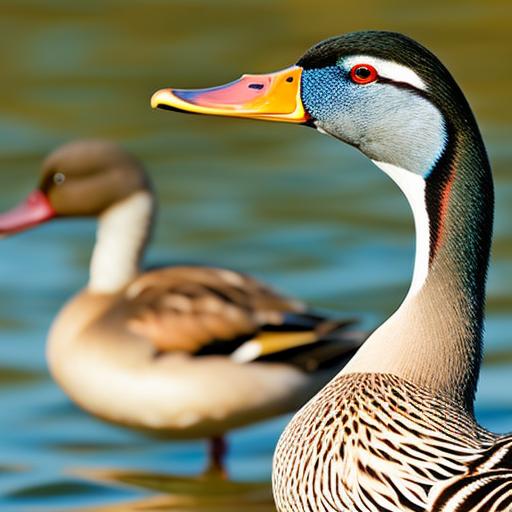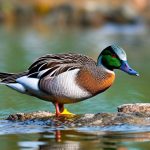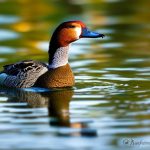Texas is home to a wide variety of duck breeds, making it a popular destination for duck hunting enthusiasts. Duck hunting has a long and storied history in Texas, with many hunters flocking to the state each year to experience the thrill of the hunt. In this article, we will explore some of the most common duck breeds found in Texas, including the Mallard, Pintail, Wood Duck, Canvasback, Redhead, Blue-Winged Teal, Gadwall, Northern Shoveler, and Ring-Necked Duck. Each breed has its own unique characteristics and behaviors that make them fascinating to observe and hunt.
Key Takeaways
- Texas is home to a variety of unique and beautiful duck breeds.
- The Mallard duck is the most common duck breed found in Texas.
- The Pintail duck is a unique and beautiful duck breed with a distinct appearance.
- The Wood duck is a colorful and adaptable duck breed that can be found in a variety of habitats.
- The Canvasback duck is a diving duck breed with a unique bill that is well-suited for feeding on aquatic plants.
The Mallard Duck
The Mallard is perhaps the most well-known and common duck breed found in Texas. It is easily recognizable by its vibrant green head, yellow bill, and brownish body. Male Mallards, known as drakes, have a distinctive curled tail feather and a white neck ring. Females, or hens, have a mottled brown appearance.
Mallards can be found in a variety of habitats, including wetlands, ponds, lakes, and rivers. They are highly adaptable and can be found throughout Texas year-round. During the breeding season, Mallards build nests on the ground near water sources and lay an average of 8-13 eggs.
Mallards are omnivorous and feed on a variety of plant matter, insects, and small aquatic animals. They are also known for their distinctive quacking call. Mallards are a popular game bird for hunters due to their abundance and delicious meat.
The Pintail Duck
The Pintail is a unique and beautiful duck breed that can be found in Texas during the winter months. It is easily recognizable by its long, slender neck and pointed tail feathers. Male Pintails have a striking plumage with a chocolate-brown head and white breast, while females have a mottled brown appearance.
Pintails prefer open water habitats such as marshes, ponds, and lakes. They are strong fliers and can often be seen in large flocks flying in V-shaped formations. Pintails are known for their graceful flight and are considered one of the fastest flying ducks.
During the breeding season, Pintails migrate to the northern parts of the United States and Canada. They build nests on the ground near water sources and lay an average of 6-10 eggs. Pintails primarily feed on plant matter, seeds, and small invertebrates.
The Wood Duck
The Wood Duck is a colorful and adaptable duck breed that can be found throughout Texas. It is easily recognizable by its iridescent green and purple head, white throat patch, and chestnut-colored body. Male Wood Ducks have a distinctive crest on their head, while females have a more subdued appearance.
Wood Ducks prefer wooded habitats near water sources such as swamps, marshes, and rivers. They are excellent tree climbers and can often be found nesting in tree cavities or man-made nest boxes. Wood Ducks are known for their whistling call, which is often described as sounding like “oo-eek.”
During the breeding season, Wood Ducks lay an average of 9-14 eggs in their nests. They primarily feed on plant matter, seeds, insects, and small aquatic animals. Wood Ducks are a popular game bird for hunters due to their beautiful plumage and delicious meat.
The Canvasback Duck
The Canvasback is a diving duck breed that can be found in Texas during the winter months. It is easily recognizable by its long, sloping bill and red head. Male Canvasbacks have a black chest and white body, while females have a mottled brown appearance.
Canvasbacks prefer large bodies of water such as lakes, reservoirs, and bays. They are strong divers and can stay submerged for long periods of time in search of food. Canvasbacks primarily feed on plant matter, seeds, and small invertebrates.
During the breeding season, Canvasbacks migrate to the northern parts of the United States and Canada. They build nests on the ground near water sources and lay an average of 6-10 eggs. Canvasbacks are a popular game bird for hunters due to their challenging nature and excellent table fare.
The Redhead Duck

The Redhead is a large and hardy duck breed that can be found in Texas during the winter months. It is easily recognizable by its bright red head, black breast, and gray body. Male Redheads have a distinctive round head shape, while females have a more subdued appearance.
Redheads prefer open water habitats such as lakes, reservoirs, and bays. They are strong fliers and can often be seen in large flocks flying in tight formations. Redheads primarily feed on plant matter, seeds, and small aquatic animals.
During the breeding season, Redheads migrate to the northern parts of the United States and Canada. They build nests on the ground near water sources and lay an average of 6-10 eggs. Redheads are a popular game bird for hunters due to their size and delicious meat.
The Blue-Winged Teal Duck
The Blue-Winged Teal is a small and fast-flying duck breed that can be found in Texas during the winter months. It is easily recognizable by its blue-gray head with a white crescent-shaped patch, brown body, and yellowish bill. Male Blue-Winged Teals have a distinctive white stripe on their face, while females have a more subdued appearance.
Blue-Winged Teals prefer shallow wetland habitats such as marshes, ponds, and flooded fields. They are strong fliers and can reach speeds of up to 60 miles per hour. Blue-Winged Teals primarily feed on plant matter, seeds, and small invertebrates.
During the breeding season, Blue-Winged Teals migrate to the northern parts of the United States and Canada. They build nests on the ground near water sources and lay an average of 8-12 eggs. Blue-Winged Teals are a popular game bird for hunters due to their fast flight and challenging nature.
The Gadwall Duck
The Gadwall is a quiet and unassuming duck breed that can be found throughout Texas. It is easily recognizable by its mottled brown appearance, grayish-brown head, and white belly. Male Gadwalls have a distinctive black rear end, while females have a more subdued appearance.
Gadwalls prefer a variety of habitats, including wetlands, ponds, lakes, and rivers. They are highly adaptable and can be found throughout Texas year-round. Gadwalls primarily feed on plant matter, seeds, and small invertebrates.
During the breeding season, Gadwalls build nests on the ground near water sources and lay an average of 8-12 eggs. They are known for their quiet quacking call and are often overlooked by hunters. Gadwalls are a popular game bird for hunters due to their abundance and delicious meat.
The Northern Shoveler Duck
The Northern Shoveler is a unique duck breed that can be found in Texas during the winter months. It is easily recognizable by its large bill with a spoon-shaped tip, green head, white breast, and chestnut-colored body. Male Northern Shovelers have a distinctive white chest and dark green head, while females have a more subdued appearance.
Northern Shovelers prefer shallow wetland habitats such as marshes, ponds, and flooded fields. They are strong fliers and can often be seen in large flocks flying in tight formations. Northern Shovelers primarily feed on plant matter, seeds, and small invertebrates.
During the breeding season, Northern Shovelers migrate to the northern parts of the United States and Canada. They build nests on the ground near water sources and lay an average of 8-12 eggs. Northern Shovelers are a popular game bird for hunters due to their unique bill shape and delicious meat.
The Ring-Necked Duck
The Ring-Necked Duck is a diving duck breed that can be found in Texas during the winter months. It is easily recognizable by its black head with a white ring around its neck, black back, and gray body. Male Ring-Necked Ducks have a distinctive white ring around their bill, while females have a more subdued appearance.
Ring-Necked Ducks prefer open water habitats such as lakes, reservoirs, and bays. They are strong divers and can stay submerged for long periods of time in search of food. Ring-Necked Ducks primarily feed on plant matter, seeds, and small invertebrates.
During the breeding season, Ring-Necked Ducks migrate to the northern parts of the United States and Canada. They build nests on the ground near water sources and lay an average of 6-10 eggs. Ring-Necked Ducks are a popular game bird for hunters due to their striking appearance and delicious meat.
Texas is home to a wide variety of duck breeds, each with its own unique characteristics and behaviors. From the common Mallard to the striking Canvasback, these ducks provide hunters with a thrilling experience and delicious table fare. However, it is important to remember the importance of conservation efforts to ensure the sustainability of these duck populations for future generations. By practicing responsible hunting and supporting habitat conservation initiatives, we can continue to enjoy the beauty and excitement of duck hunting in Texas. So grab your gear and head out to the wetlands of Texas for an unforgettable duck hunting experience.
If you’re interested in learning more about Texas duck breeds, you might also find this article on poultrywizard.com helpful. It discusses the importance of providing a suitable chicken coop for your ducks, just like you would for chickens. The article provides valuable insights on how to design and build a portable chicken coop that can be easily moved around your property. Check it out here: https://poultrywizard.com/keeping-chickens/chicken-coop-portage/.
FAQs
What are the different duck breeds found in Texas?
There are several duck breeds found in Texas, including the Mallard, Wood Duck, Mottled Duck, Blue-winged Teal, Green-winged Teal, Northern Pintail, Gadwall, American Wigeon, and Canvasback.
What is the most common duck breed found in Texas?
The Mallard is the most common duck breed found in Texas. They are found in wetlands, ponds, and lakes throughout the state.
What is the size of Texas duck breeds?
The size of Texas duck breeds varies depending on the breed. Mallards can weigh up to 3 pounds, while Canvasbacks can weigh up to 3.5 pounds.
What is the habitat of Texas duck breeds?
Texas duck breeds can be found in a variety of habitats, including wetlands, ponds, lakes, rivers, and coastal areas.
What is the diet of Texas duck breeds?
Texas duck breeds primarily feed on aquatic plants, insects, and small aquatic animals such as snails and crustaceans.
Are Texas duck breeds migratory?
Yes, many Texas duck breeds are migratory and travel to other parts of North America during the winter months. However, some breeds such as the Mottled Duck are non-migratory and remain in Texas year-round.
What is the hunting season for Texas duck breeds?
The hunting season for Texas duck breeds varies depending on the breed and location. Generally, the season runs from November to January. Hunters must have a valid hunting license and follow all state and federal regulations.
Meet Walter, the feathered-friend fanatic of Florida! Nestled in the sunshine state, Walter struts through life with his feathered companions, clucking his way to happiness. With a coop that’s fancier than a five-star hotel, he’s the Don Juan of the chicken world. When he’s not teaching his hens to do the cha-cha, you’ll find him in a heated debate with his prized rooster, Sir Clucks-a-Lot. Walter’s poultry passion is no yolk; he’s the sunny-side-up guy you never knew you needed in your flock of friends!







